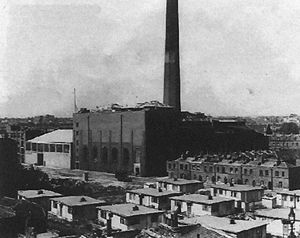Famous Players-Lasky
Famous Players-Lasky Corporation was an American motion picture and distribution company created on July 19, 1916 from the merger of Adolph Zukor's Famous Players Film Company — originally formed by Zukor as Famous Players in Famous Plays — and Jesse L. Lasky's Feature Play Company.
In September 1927, Famous Players-Lasky was reorganized under the name Paramount Famous Lasky Corporation, later becoming the Paramount Pictures Corporation.
Famous Players-Lasky British Producers Limited

In April 1919, the company established itself in the United Kingdom as Famous Players-Lasky British Producers Limited. After spending several months looking for a suitable location for their new studios, the company rented a large plot of land in Islington, London in October 1919. Part of the plot included a large glass-roofed building (formerly a power station) which was refurbished to create new state-of-the-art studios, including a large tank for filming underwater sequences. [1]
Alma Reville, who had spent the previous six years working for the London Film Company based in Twickenham, began working at the Islington Studios in early 1921 as the Floor Secretary to actor-director Donald Crisp.[2]
Alfred Hitchcock, who was working at W.T. Henley's Telegraph Works at the time the studios opened, designed portfolios of title cards for The Sorrows of Satan and The Great Day and presented himself at the studio in the hope of securing work. Norman Gregory Arnold, Islington's Supervising Art Director, was impressed enough to hire Hitchcock and he began working on a part-time freelance basis before eventually becoming a full-time employee in April 1921.[3]
It is assumed Hitchcock designed the title cards for the majority, if not all, of the company's UK productions, including:[4]
- The Great Day (1921)
- The Call of Youth (1921)
- Appearances (1921)
- The Mystery Road (1921)
- Dangerous Lies (1921)
- The Princess of New York (1921)
- The Bonnie Brier Bush (1921)
- Three Live Ghosts (1922)
- Love's Boomerang (1922)
- The Spanish Jade (1922)
According to Hitchcock, he gradually took on more roles within the company over time.
Despite an ambitious initial programme of films, the company suspended its productions during the summer of 1922 and laid off many of the staff — including Alma Reville.[5]
At some point during 1922, it is believed Hitchcock penned the screenplay treatment for a film entitled Good Night, Nurse!, although it's unknown if this was planned to be a Famous Players-Lasky production as it remained unfilmed.
See Also...
Books
Links
References
- ↑ Alfred Hitchcock: A Life in Darkness and Light (2003) by Patrick McGilligan, page 47-48
- ↑ Alfred Hitchcock: A Life in Darkness and Light (2003) by Patrick McGilligan, page 53
- ↑ Alfred Hitchcock: A Life in Darkness and Light (2003) by Patrick McGilligan, page 46
- ↑ Alfred Hitchcock: A Life in Darkness and Light (2003) by Patrick McGilligan, page 50
- ↑ Alfred Hitchcock: A Life in Darkness and Light (2003) by Patrick McGilligan, page 53-54
